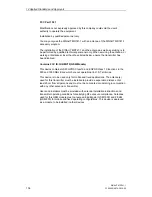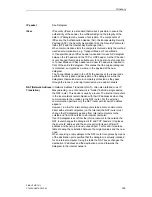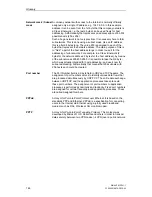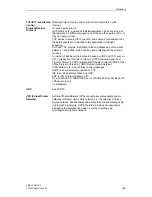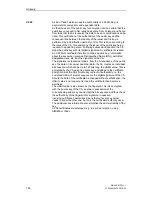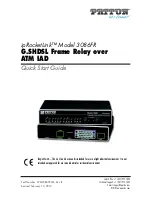
Glossary
SINAUT MD741-1
142
C79000-G8976-C236-05
Datagram
In the transmission protocol TCP/IP, data are sent in the form of data
packets, the so-called IP datagrams. An IP datagram has the following
structure:
1. IP Header
2. TCP/UDP Header
3. Data (Payload)
The IP Header contains:
the IP address of the sender (source IP address)
the IP address of the recipient (destination IP address)
the protocol number of the protocol of the next higher protocol
layer (according to the OSI layer model)
the IP Header Checksum for checking the integrity of the header
upon receipt.
TCP/UDP Header contains the following information:
the port of the sender (source port)
the port of the recipient (destination port)
a checksum for the TCP Header and a few items of information
from the IP Header (source and destination IP addresses, etc.)
DES/3DES
The symmetrical encryption algorithm (
symmetrical encryption)
DES, originally developed by IBM and checked by the NSA, was
determined in 1977 by the American National Bureau of Standards, the
predecessor of today's National Institute of Standards and Technology
(NIST), as the standard for American government institutions.
As this was the first standardized encryption algorithm of all, it quickly
established itself in industry and hence outside the USA.
DES works with a key length of 56 bits, which is no longer considered
secure due to the increase in computing power since 1977.
3DES is a variant of DES. It works with 3-times larger keys, i.e. 168
bits long. It is still considered secure today and is, among other things,
also part of the IPsec standard.
DHCP
The Dynamic Host Configuration Protocol (DHCP) performs automatic
dynamic assignment of IP addresses and other parameters in a
network. The Dynamic Host Configuration Protocol uses UDP. It was
defined in RFC 2131 and was assigned the UDP ports 67 and 68.
DHCP uses the client – server method, in which the client is assigned
the IP addresses by the server.
DNS
Addressing in IP networks is always by means of IP addresses. It is
generally preferable, however, to specify the addressing in the form of
a domain address (i.e. in the form www.abc.xyz.de). If the addressing
is by means of the domain address, then the sender first sends the
domain address to a domain name server (DNS) and gets back the
associated IP address. Only then does the sender address its data to
this IP address.









